A Water Footprint Based Hydro-Economic Model for Minimizing the Blue Water to Green Water Ratio in the Zarrinehrud River-Basin in Iran
Abstract
:1. Introduction
2. Proposed Methodology and Model Structure
2.1. Evapotranspiration Model (Water Demand Modeling)
2.2. Water Footprint Module
2.3. Economic Module
2.4. Optimizing Module
3. Case Study
4. Results and Discussion
4.1. Model Setup
4.2. WF and Agricultural Benefits for the Existing Condition
4.3. Crop Pattern
4.3.1. Dry Year Scenario
4.3.2. Moderate Year Scenario
4.3.3. Wet Year Scenario
5. Conclusions
Author Contributions
Funding
Conflicts of Interest
References
- Falkenmark, M.; Rockström, J. The New Blue and Green Water Paradigm: Breaking New Ground for Water Resources Planning and Management; American Society of Civil Engineers: Reston, VI, USA, 2006. [Google Scholar]
- Falkenmark, M.; Rockström, J. Balancing Water for Humans and Nature: The New Approach in Ecohydrology; Earthscan: Abingdon, UK, 2013. [Google Scholar]
- Molden, D. Water for Food Water for Life: A Comprehensive Assessment of Water Management in Agriculture; Routledge: Abingdon-on-Thames, UK, 2013. [Google Scholar]
- Aldaya, M.M.; Allan, J.A.; Hoekstra, A.Y. Strategic importance of green water in international crop trade. Ecol. Econ. 2010, 69, 887–894. [Google Scholar] [CrossRef] [Green Version]
- Hoekstra, A.Y.; Mekonnen, M.M. The water footprint of humanity. Proc. Natl. Acad. Sci. USA 2012, 109, 3232–3237. [Google Scholar] [CrossRef] [PubMed] [Green Version]
- Amarasinghe, U.A.; Smakhtin, V. Water productivity and water footprint: Misguided concepts or useful tools in water management and policy? Water Int. 2014, 39, 1000–1017. [Google Scholar] [CrossRef]
- Tadayon, M.R.; Ebrahimi, R.; Tadayyon, A. Increased water productivity of wheat under supplemental irrigation and nitrogen application in a semi-arid region. J. Agric. Sci. Technol. 2012, 14, 995–1003. [Google Scholar]
- Falkenmark, M. Land-water linkages: A synopsis. In Land and Water Bulletin: Land and Water Integration and River Basin Management; Food and Agriculture Organization (FAO) of the United Nations: Rome, Italy, 1995; Volume 1, pp. 15–16. [Google Scholar]
- Mekonnen, M.; Hoekstra, A.Y. National Water Footprint Accounts: The Green, Blue and Grey Water Footprint of Production and Consumption; Unesco-IHE Institute for Water Education: Delft, The Netherlands, 2011. [Google Scholar]
- Aldaya, M.M.; Chapagain, A.K.; Hoekstra, A.Y.; Mekonnen, M.M. The Water Footprint Assessment Manual: Setting the Global Standard; Routledge: Abingdon-on-Thames, UK, 2012. [Google Scholar]
- Faramarzi, M.; Abbaspour, K.C.; Schulin, R.; Yang, H. Modelling blue and green water resources availability in Iran. Hydrol. Process. 2009, 23, 486–501. [Google Scholar] [CrossRef]
- Chapagain, A.K.; Hoekstra, A.Y.; Savenije, H.H.G.; Gautam, R. The water footprint of cotton consumption: An assessment of the impact of worldwide consumption of cotton products on the water resources in the cotton producing countries. Ecol. Econ. 2006, 60, 186–203. [Google Scholar] [CrossRef]
- Chapagain, A.K.; Hoekstra, A.Y.; Savenije, H.H.G. Water saving through international trade of agricultural products. Hydrol. Earth Syst. Sci. Discuss. 2006, 10, 455–468. [Google Scholar] [CrossRef] [Green Version]
- Chen, K.; Yang, S.; Zhao, C.; Li, Z.; Luo, Y.; Wang, Z.; Liu, X.; Guan, Y.; Bai, J.; Zhou, Q.; et al. Conversion of Blue Water into Green Water for Improving Utilization Ratio of Water Resources in Degraded Karst Areas. Water 2016, 8, 569. [Google Scholar] [CrossRef]
- Dumont, A.; Salmoral, G.; Llamas, M.R. The water footprint of a river basin with a special focus on groundwater: The case of Guadalquivir basin (Spain). Water Resour. Ind. 2013, 1, 60–76. [Google Scholar] [CrossRef]
- Afshar, A.; Neshat, A. Evaluation of Aqua Crop computer model in the potato under irrigation management of continuity plan of Jiroft region, Kerman, Iran. Int. J. Adv. Biol. Biomed. Res. 2013, 1, 1669–1678. [Google Scholar]
- Chukalla, A.D.; Krol, M.S.; Hoekstra, A.Y. Green and blue water footprint reduction in irrigated agriculture: Effect of irrigation techniques, irrigation strategies and mulching. Hydrol. Earth Syst. Sci. 2015, 19, 4877. [Google Scholar] [CrossRef]
- El-Gafy, I.K. System dynamic model for crop production, water footprint, and virtual water nexus. Water Resour. Manag. 2014, 28, 4467–4490. [Google Scholar] [CrossRef]
- AnyLogic. AnyLogic Company: Oakbrook Terrace, IL, USA. (Used Free Trial). Available online: https://www.anylogic.com (accessed on 30 September 2018).
- McKee, T.B.; Doesken, N.J.; Kleist, J. The relationship of drought frequency and duration to time scales. In Proceedings of the 8th Conference on Applied Climatology, Anaheim, CA, USA, 17–22 January 1993; Volume 17, pp. 179–183. [Google Scholar]
- McKee, T.B. Drought monitoring with multiple time scales. In Proceedings of the 9th Conference on Applied Climatology, Boston, MA, USA, 15–20 January 1995. [Google Scholar]
- Hayes, M.J.; Svoboda, M.D.; Wiihite, D.A.; Vanyarkho, O.V. Monitoring the 1996 drought using the standardized precipitation index. Bull. Am. Meteorol. Soc. 1999, 80, 429–438. [Google Scholar] [CrossRef]
- Edwards, D.C. Characteristics of 20th Century Drought in the United States at Multiple Time Scales; Air Force Inst Of Tech: Wright-Patterson Afb, OH, USA, 1997. [Google Scholar]
- Cronshey, R.G.; Roberts, R.T.; Miller, N. Urban hydrology for small watersheds (TR-55 Rev.). In Hydraulics and Hydrology in the Small Computer Age; American Society of Civil Engineers: Reston, VI, USA, 1985; pp. 1268–1273. [Google Scholar]
- Steduto, P.; Hsiao, T.C.; Fereres, E.; Raes, D. Crop Yield Response to Water; FAO: Rome, Italy, 2012; Volume 1028. [Google Scholar]
- FAO. AQUASTAT—FAO’s Information System on Water and Agriculture; Food and Agriculture Organization: Rome, Italy, 2007; Available online: www.fao.org/nr/water/%0Aaquastat/main/index.stm%0A (accessed on 30 September 2018).
- FAO. CROPWAT Model; Food and Agriculture Organization: Rome, Italy, 2003. [Google Scholar]
- Kleijnen, J.P.C.; Wan, J. Optimization of simulated systems: OptQuest and alternatives. Simul. Model. Pract. Theory 2007, 15, 354–362. [Google Scholar] [CrossRef]
- Laguna, M. OptQuest: Optimization of Complex Systems; White Pap.; OptTek Syst. Inc.: Boulder, CO, USA, 2011; Available online: http//www.opttek.com/white-papers (accessed on 30 September 2018).
- Kelts, K.; Shahrabi, M. Holocene sedimentology of hypersaline Lake Urmia, northwestern Iran. Palaeogeogr. Palaeoclimatol. Palaeoecol. 1986, 54, 105–130. [Google Scholar] [CrossRef]
- Ghaheri, M.; Baghal-Vayjooee, M.H.; Naziri, J. Lake Urmia, Iran: A summary review. Int. J. Salt Lake Res. 1999, 8, 19–22. [Google Scholar] [CrossRef]
- Eimanifar, A.; Mohebbi, F. Urmia Lake (northwest Iran): A brief review. Saline Syst. 2007, 3, 5. [Google Scholar] [CrossRef]
- Karbassi, A.; Bidhendi, G.N.; Pejman, A.; Bidhendi, M.E. Environmental impacts of desalination on the ecology of Lake Urmia. J. Gt. Lakes Res. 2010, 36, 419–424. [Google Scholar] [CrossRef]
- Lotfi, A.; Moser, M. A Concise Baseline Report: Lake Uromiyeh; Conservation of Iranian Wetlands Project; IRI Department of Environment, United Nations Development Program: Pardisan Park, Tehran, Iran, 2012. (In English) [Google Scholar]
- Asem, A.; Eimanifar, A.; Djamali, M.; de los Rios, P.; Wink, M. Biodiversity of the hypersaline Urmia Lake national park (NW Iran). Diversity 2014, 6, 102–132. [Google Scholar] [CrossRef]
- Urmia Lake Restoration Program. 2015. Available online: http://ulrp.sharif.ir/en (accessed on 29 July 2016).
- Zeinoddini, M.; Tofighi, M.A.; Vafaee, F. Evaluation of dike-type causeway impacts on the flow and salinity regimes in Urmia Lake, Iran. J. Gt. Lakes Res. 2009, 35, 13–22. [Google Scholar] [CrossRef]
- Allen, R.G.; Pereira, L.S.; Raes, D.; Smith, M. Crop Evapotranspiration-Guidelines for Computing Crop Water Requirements; FAO Irrigation and Drainage Paper 56; FAO: Rome, Italy, 1998; Volume 300, p. D05109. [Google Scholar]
- Kaini, P.; Nicklow, J.W.; Schoof, J.T. Impact of climate change projections and best management practices on river flows and sediment load. In Proceedings of the World Environmental and Water Resources Congress 2010: Challenges of Change, Providence, RI, USA, 16–20 May 2010; pp. 2269–2277. [Google Scholar]
- Afshar, A.; Massoumi, F.; Afshar, A.; Mariño, M.A. State of the art review of ant colony optimization applications in water resource management. Water Resour. Manag. 2015, 29, 3891–3904. [Google Scholar] [CrossRef]
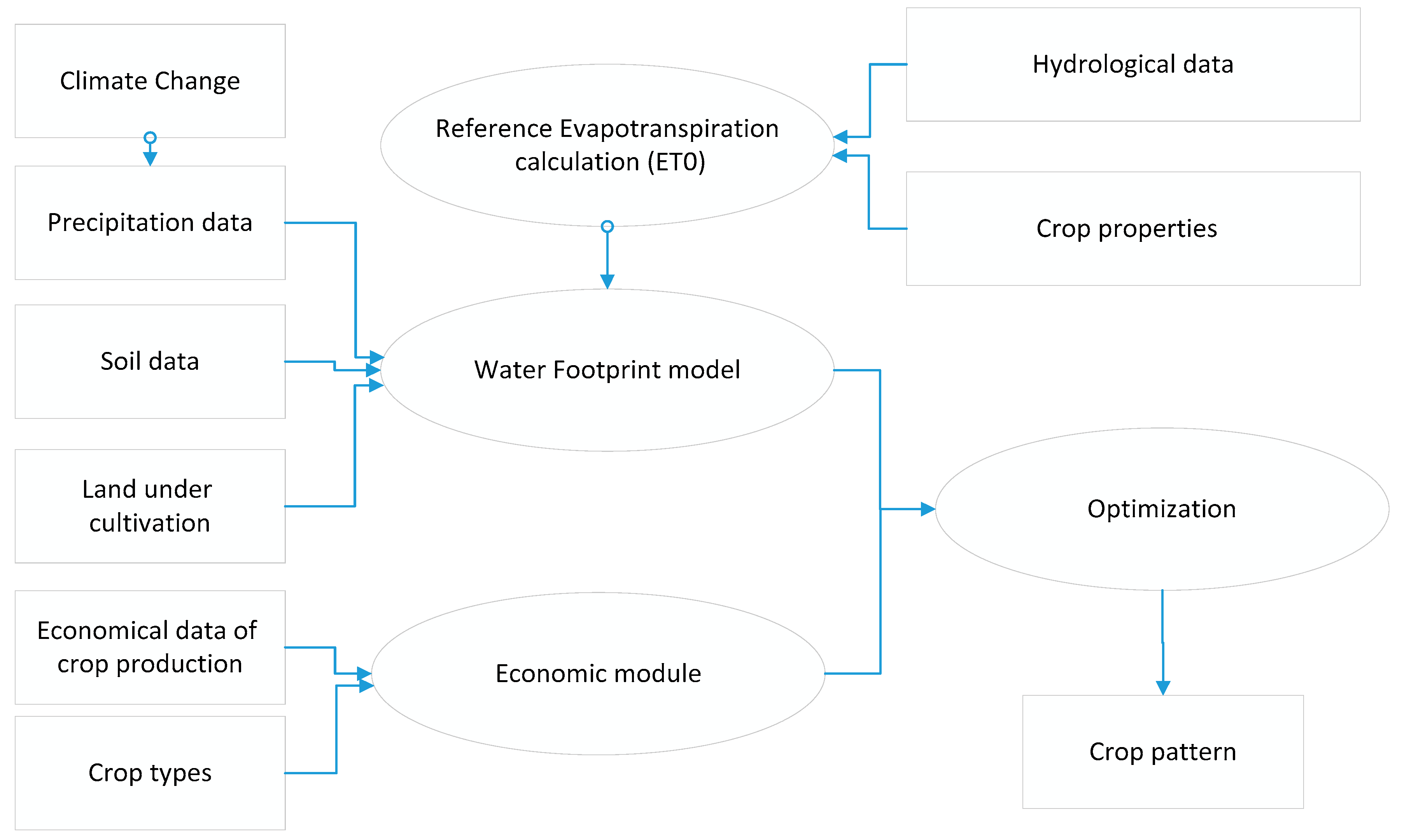
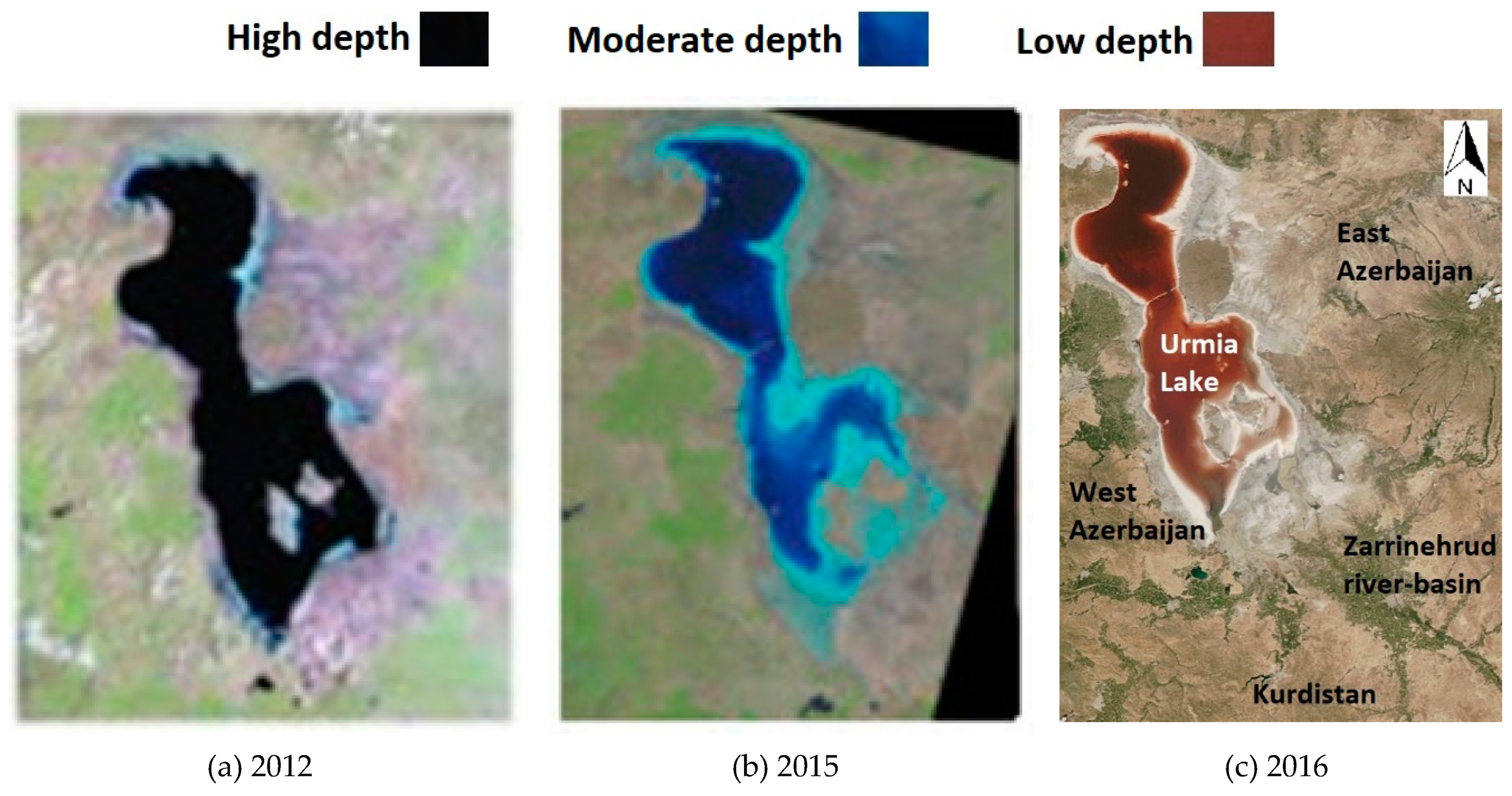


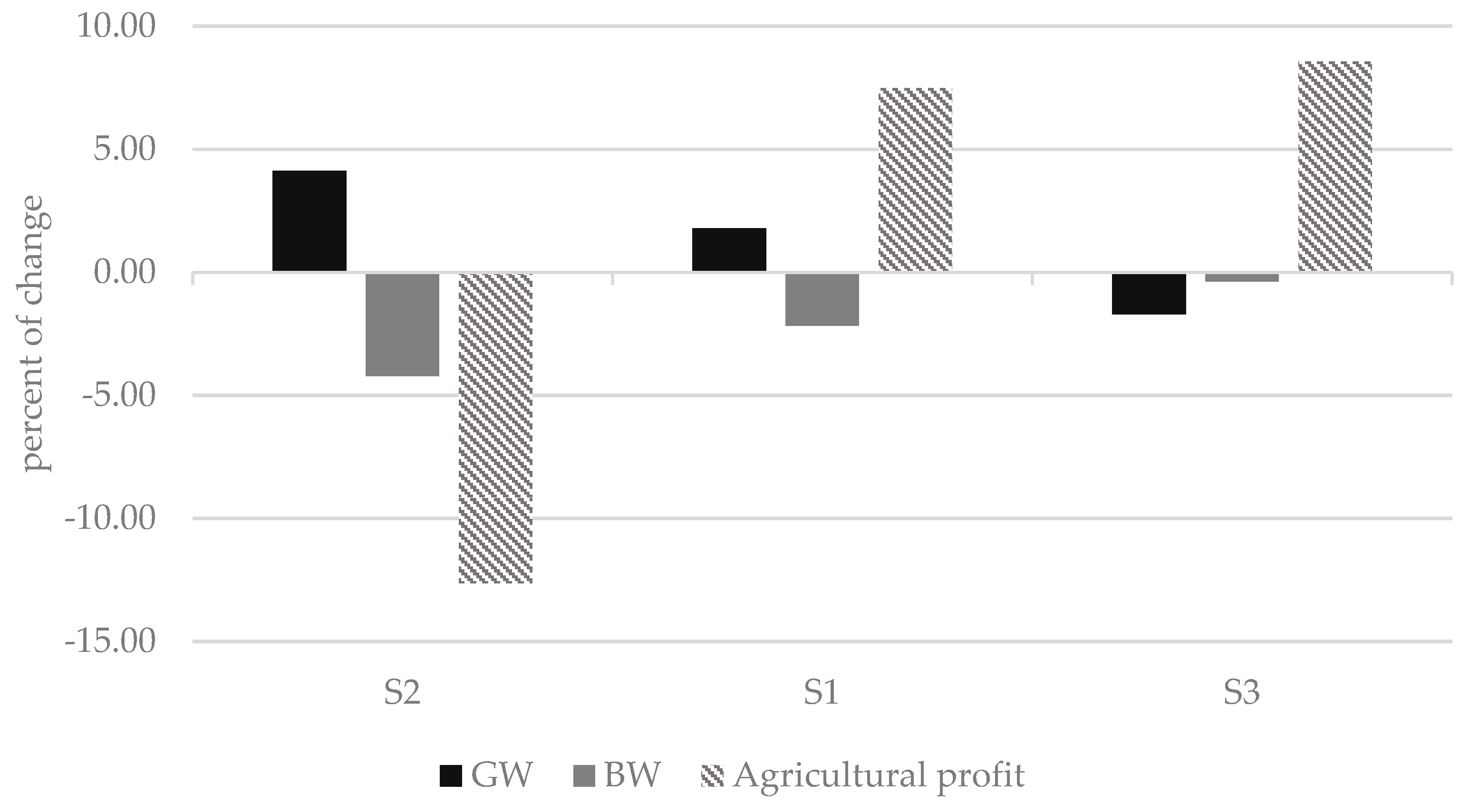



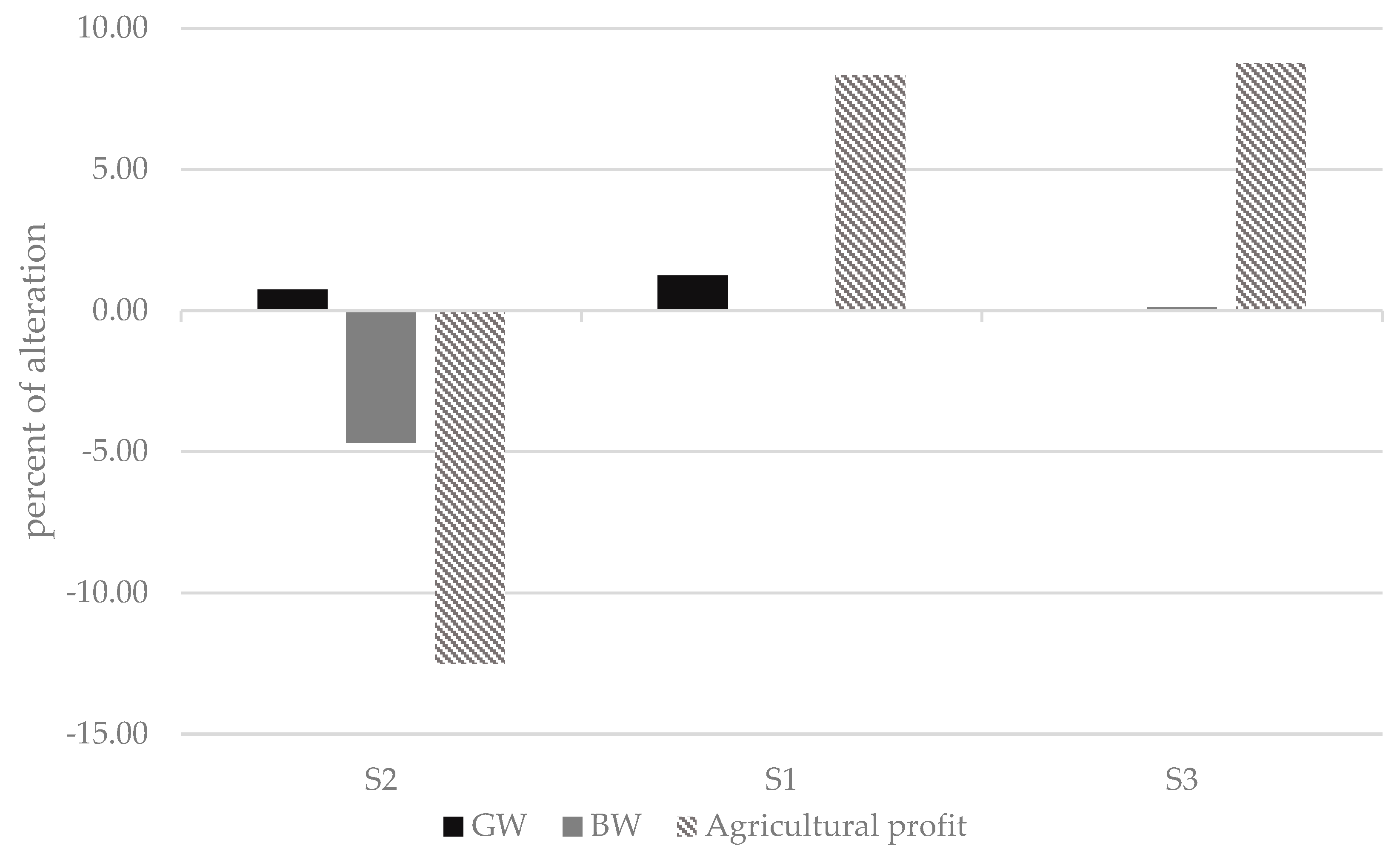
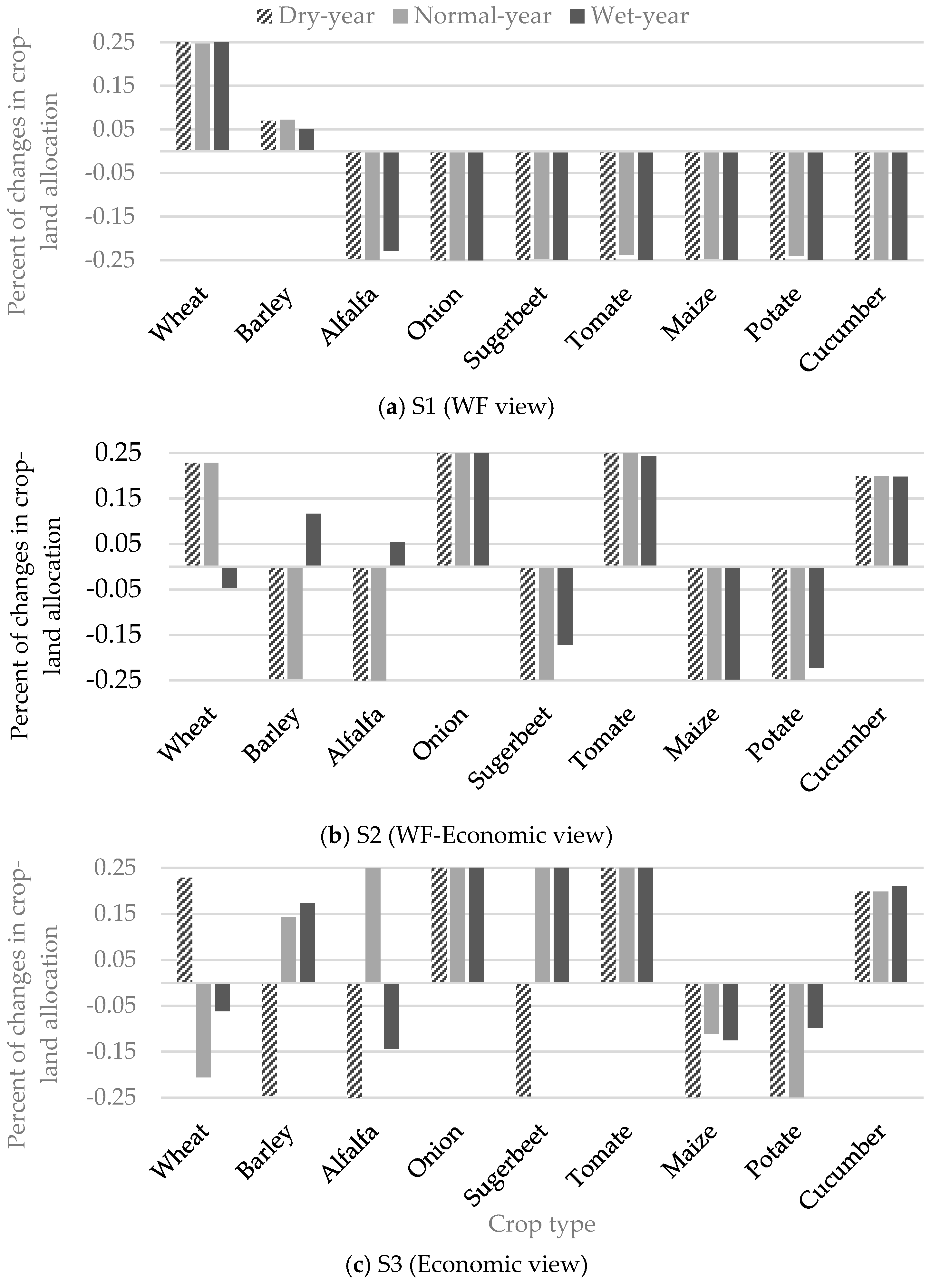
| Scenarios | Rainfall Data |
|---|---|
| Dry year | The average of monthly rainfall data of years during the 30-year period in which their SPI is less than or equal to −1 |
| Moderate year | The average of monthly rainfall data of years during the 30-year period in which their SPI is between −1 and 1 |
| Wet year | The average of monthly rainfall data of years during the 30-year period in which their SPI is more than or equal to 1 |
| Agricultural Gross Profit (Tooman/Ha) | Cost of Crop Production (Tooman/Kg) | |||||
|---|---|---|---|---|---|---|
| Crops | Azerbaijan Gharbi | Azerbaijan Sharghi | Kurdistan | Azerbaijan Gharbi | Azerbaijan Sharghi | Kurdistan |
| Wheat | 720,937 | 661,843 | 718,257 | 1200 | 1300 | 1155 |
| Barley | 804,350 | 532,382 | 614,530 | 1250 | 1300 | 920 |
| Alfalfa | 1,378,845 | 775,492 | 1,394,939 | 550 | 700 | 518 |
| Onion | 3,467,196 | 3,348,287 | 1,832,148 | 1800 | 1500 | 2400 |
| Sugar beet | 2,674,087 | 2,674,087 | 2,674,087 | 270 | 250 | 300 |
| Tomato | 2,470,183 | 2,460,549 | 2,174,020 | 500 | 600 | 578 |
| Maize | 977,061 | 944,719 | 777,667 | 900 | 800 | 960 |
| Potato | 4,298,140 | 1,087,735 | 3,973,447 | 400 | 350 | 285 |
| Cucumber | 3,506,146 | 1,481,580 | 2,406,674 | 1200 | 1500 | 1320 |
| Grapes | 2,000,000 | 2,000,000 | 2,000,000 | 2500 | 2000 | 2170 |
| Apple | 6,500,000 | 6,500,000 | 6,500,000 | 1500 | 1800 | 1420 |
| Peach | 3,500,000 | 3,500,000 | 3,500,000 | 2200 | 2000 | 2000 |
| Agricultural Sites | WF Consumption for Crop Production (MCM) | Agricultural Profit (Billion Tooman) |
|---|---|---|
| Ajorloo | 3.2 | 5.8 |
| Baroogh | 6.5 | 11 |
| Zarrinehrud | 71.4 | 140.1 |
| Legzi | 2.0 | 2.8 |
| Saroogh | 4.9 | 8.3 |
| Zarrinehrud Irr & Dr Network | 2.7 | 3.7 |
| Malekan | 12.7 | 18 |
| Cheraghveis | 4.5 | 7.6 |
| Sonate | 9.5 | 16.3 |
| Sum | 117.4 | 213.6 |
| Scenarios | S2 (WF View) | S1 (WF-Economic View) |
|---|---|---|
| dry-year | −8% | −3.9% |
| moderate-year | −8.2% | −4% |
| wet-year | −5.4% | −1.2% |
© 2018 by the authors. Licensee MDPI, Basel, Switzerland. This article is an open access article distributed under the terms and conditions of the Creative Commons Attribution (CC BY) license (http://creativecommons.org/licenses/by/4.0/).
Share and Cite
Saed, B.; Afshar, A.; Jalali, M.R.; Ghoreishi, M.; Aminpour Mohammadabadi, P. A Water Footprint Based Hydro-Economic Model for Minimizing the Blue Water to Green Water Ratio in the Zarrinehrud River-Basin in Iran. AgriEngineering 2019, 1, 58-74. https://doi.org/10.3390/agriengineering1010005
Saed B, Afshar A, Jalali MR, Ghoreishi M, Aminpour Mohammadabadi P. A Water Footprint Based Hydro-Economic Model for Minimizing the Blue Water to Green Water Ratio in the Zarrinehrud River-Basin in Iran. AgriEngineering. 2019; 1(1):58-74. https://doi.org/10.3390/agriengineering1010005
Chicago/Turabian StyleSaed, Behdad, Abbas Afshar, Mohammad Reza Jalali, Mohammad Ghoreishi, and Payam Aminpour Mohammadabadi. 2019. "A Water Footprint Based Hydro-Economic Model for Minimizing the Blue Water to Green Water Ratio in the Zarrinehrud River-Basin in Iran" AgriEngineering 1, no. 1: 58-74. https://doi.org/10.3390/agriengineering1010005





